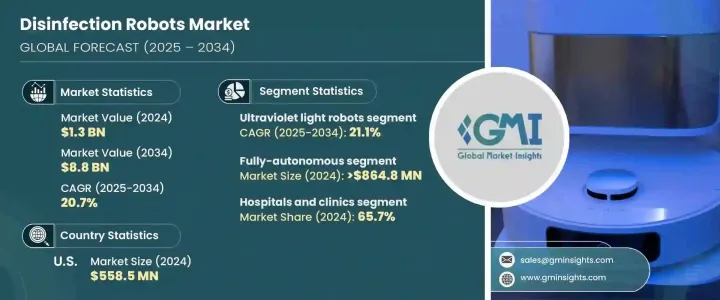PUBLISHER: Global Market Insights Inc. | PRODUCT CODE: 1684199

PUBLISHER: Global Market Insights Inc. | PRODUCT CODE: 1684199
Disinfection Robots Market Opportunity, Growth Drivers, Industry Trend Analysis, and Forecast 2025 - 2034
The Global Disinfection Robots Market reached USD 1.3 billion in 2024 and is projected to expand at an impressive CAGR of 20.7% between 2025 and 2034. This rapid growth reflects increasing awareness around infection control, ongoing labor shortages, cost efficiency, and a heightened focus on sustainable, chemical-free disinfection methods. The COVID-19 pandemic has underscored the critical importance of maintaining stringent hygiene standards, thus pushing healthcare, hospitality, and public spaces to adopt advanced disinfection solutions.

The shift towards automation, driven by technological advancements in robotics and artificial intelligence, has further bolstered the demand for innovative disinfection robots that provide superior cleaning outcomes while reducing human intervention. As organizations strive to meet rigorous disinfection standards and ensure the safety of personnel and customers, the market is expected to witness robust investment and innovation in the coming years.
| Market Scope | |
|---|---|
| Start Year | 2024 |
| Forecast Year | 2025-2034 |
| Start Value | $1.3 Billion |
| Forecast Value | $8.8 Billion |
| CAGR | 20.7% |
By product type, the market is segmented into ultraviolet light robots, hydrogen peroxide vapor (HPV) robots, and others. Ultraviolet light robots are anticipated to dominate the market, growing at a remarkable CAGR of 21.1% and reaching USD 5.6 billion by 2034. These robots leverage UV-C technology, which effectively inactivates a broad spectrum of microorganisms by damaging their genetic material, preventing replication. This cutting-edge technology offers a fast, efficient, and environmentally friendly solution, achieving up to 99.99% disinfection within minutes. Ultraviolet light robots are increasingly preferred across industries for their ability to deliver consistent and reliable pathogen elimination, presenting a superior alternative to traditional cleaning methods.
In terms of technology, fully autonomous and semi-autonomous robots drive innovation in the market. Fully autonomous disinfection robots, which generated USD 864.8 million in 2024, are revolutionizing infection control with their ability to minimize reliance on manual labor. These robots operate continuously with minimal downtime, ensuring consistent and efficient cleaning in diverse settings. Equipped with advanced artificial intelligence (AI) navigation systems and LiDAR mapping technologies, fully autonomous robots can identify target areas, navigate obstacles, and disinfect even the most complex and hard-to-access spaces. This capability makes them particularly valuable in high-risk environments such as hospitals, airports, and public transportation hubs.
The U.S. disinfection robots market generated USD 558.5 million in 2024 and is expected to grow at a robust CAGR of 19.1% through 2034. The high prevalence of healthcare-associated infections (HAIs) in the country has accelerated the adoption of advanced disinfection solutions. These infections lead to longer hospital stays and higher medical costs, prompting healthcare facilities to embrace disinfection robots that utilize UV-C light and HPV technologies. Fully autonomous robots with state-of-the-art navigation, AI capabilities, and real-time reporting are increasingly favored to address labor shortages and maintain stringent cleaning standards across the healthcare sector.
Table of Contents
Chapter 1 Methodology and Scope
- 1.1 Market scope and definitions
- 1.2 Research design
- 1.2.1 Research approach
- 1.2.2 Data collection methods
- 1.3 Base estimates and calculations
- 1.3.1 Base year calculation
- 1.3.2 Key trends for market estimation
- 1.4 Forecast model
- 1.5 Primary research and validation
- 1.5.1 Primary sources
- 1.5.2 Data mining sources
Chapter 2 Executive Summary
- 2.1 Industry 3600 synopsis
Chapter 3 Industry Insights
- 3.1 Industry ecosystem analysis
- 3.2 Industry impact forces
- 3.2.1 Growth drivers
- 3.2.1.1 High incidence of hospital-acquired infections
- 3.2.1.2 Technological advancements in products
- 3.2.1.3 Rise in sanitation and hygiene related spending in healthcare settings post-pandemic
- 3.2.2 Industry pitfalls and challenges
- 3.2.2.1 High product cost
- 3.2.1 Growth drivers
- 3.3 Growth potential analysis
- 3.4 Regulatory landscape
- 3.5 Reimbursement scenario
- 3.6 Pricing analysis
- 3.7 Technology landscape
- 3.8 Gap analysis
- 3.9 Porter's analysis
- 3.10 PESTEL analysis
Chapter 4 Competitive Landscape, 2024
- 4.1 Introduction
- 4.2 Company matrix analysis
- 4.3 Company market share analysis
- 4.4 Competitive analysis of major market players
- 4.5 Competitive positioning matrix
- 4.6 Strategy dashboard
Chapter 5 Market Estimates and Forecast, By Product Type, 2021 — 2034 ($ Mn)
- 5.1 Key trends
- 5.2 Ultraviolet light robots
- 5.3 Hydrogen peroxide vapor (HPV) robots
- 5.4 Other product types
Chapter 6 Market Estimates and Forecast, By Technology, 2021 — 2034 ($ Mn)
- 6.1 Key trends
- 6.2 Fully-autonomous
- 6.3 Semi-autonomous
Chapter 7 Market Estimates and Forecast, By End Use, 2021 — 2034 ($ Mn)
- 7.1 Key trends
- 7.2 Hospitals and clinics
- 7.3 Ambulatory surgical centers (ASCs)
- 7.4 Pharmaceutical and biotechnology facilities
- 7.5 Other end users
Chapter 8 Market Estimates and Forecast, By Region, 2021 — 2034 ($ Mn)
- 8.1 Key trends
- 8.2 North America
- 8.2.1 U.S.
- 8.2.2 Canada
- 8.3 Europe
- 8.3.1 Germany
- 8.3.2 UK
- 8.3.3 France
- 8.3.4 Spain
- 8.3.5 Italy
- 8.3.6 Netherlands
- 8.4 Asia Pacific
- 8.4.1 China
- 8.4.2 Japan
- 8.4.3 India
- 8.4.4 Australia
- 8.4.5 South Korea
- 8.5 Latin America
- 8.5.1 Brazil
- 8.5.2 Mexico
- 8.5.3 Argentina
- 8.6 Middle East and Africa
- 8.6.1 South Africa
- 8.6.2 Saudi Arabia
- 8.6.3 UAE
Chapter 9 Company Profiles
- 9.1 ADIBOT
- 9.2 akara
- 9.3 ATEAGO
- 9.4 bioquell
- 9.5 BLUE OCEAN ROBOTICS
- 9.6 BRIDGEPORT MAGNETICS
- 9.7 Finsen TECH
- 9.8 Jetbrain
- 9.9 Mediland Enterprise
- 9.10 mILAGROW
- 9.11 OTSAW
- 9.12 skytron
- 9.13 TMirob
- 9.14 Tru-D
- 9.15 XENEX




